The adoption of hybrid project management methodologies is on the rise. Scrumfall, one of the more widely used hybrid approaches, is compatible with many of the best project management software platforms. Scrumfall combines highly structured processes from the traditional Waterfall approach with more flexible systems from the Agile Scrum framework.
In this guide, we’ll explain what Scrumfall is and examine how it compares to Waterfall and Scrum. You’ll learn about its advantages and disadvantages, and discover why many software development organizations are adopting the Scrumfall approach. We know you’re eager to learn, so let’s get started.
What Is Water-Scrum-Fall?
Scrumfall, also called Water-Scrum-Fall, is a hybrid approach to project management that combines elements from the traditional Waterfall approach (like planning, budgeting and documentation) with Agile principles and processes (like sprints and communication methods) found in the Scrum framework.
In Scrumfall, project managers complete a Waterfall planning process where project details are mapped out before the project starts. Development teams then use sprints (iterative development cycles) based on Scrum development methodologies to complete their work. After completion, projects transition to a traditional software maintenance stage based on Waterfall.
Scrum vs Waterfall vs Scrumfall
Before we go any further, it’s important to explain the key differences between Scrum, Waterfall and Scrumfall, as they are all distinct approaches to project management.
Waterfall
Waterfall is a highly structured project management methodology in which a project manager creates a project plan and adheres to it as closely as possible throughout the project’s life cycle. Waterfall projects contain multiple stages that house many tasks. These phases are:
- Establishing requirements and gathering documents
- Planning
- Development
- Testing
- Deployment and support

Projects that use the Waterfall method are plotted in Gantt charts. These charts contain the phases of a project and the tasks to complete within those phases. Once a task has been completed, project teams flow down the waterfall to the next task. Once all tasks within a phase are completed — when a milestone is reached — teams move on to the next phase.
There’s no denying that following a project’s path is straightforward with the Waterfall method. However, because teams work until a project phase and all of its tasks are complete, and because product testing is not complete until development is finished, it can be hard to go back up the waterfall to fix problems, which is problematic when designing a software system.
Organizations that use Waterfall usually adopt a centralized organizational structure. Executives make project decisions, which flow down to mid-level managers and developers. Waterfall also defines team member roles via RACI charts. This structure can aid communication by clarifying who should be contacted for specific issues, but it can slow down decision-making processes.
Scrum
Software developers who grew tired of restrictive project management methodologies like Waterfall designed Scrum. Scrum allows teams to speed up development processes, collaborate freely and release working iterations of software every one to four weeks, increasing customer satisfaction.
The Scrum framework incorporates the flexible Agile guidelines and development principles found in the Agile Manifesto. The manifesto and all Agile frameworks favor:
- Individuals and actions over processes and tools
- Working software over comprehensive documentation
- Customer collaboration over contract negotiation
- Responding to change over following a plan

help teams track a project’s progress.
A scrum team uses kanban boards to track features (tasks) that must be completed during a sprint (a time-boxed event that lasts one to four weeks). At the end of a sprint, the development team demos the latest version of the software to stakeholders and clients in a sprint review, during which time the team can receive feedback and accept new feature requests.
Scrum allows software development teams to respond to changing markets and new customer demands on the fly by collaborating directly with stakeholders and clients. Scrum, which uses cross-functional teams to create frequent working iterations of software, uses a decentralized organizational structure, allowing all team members to make project decisions.
Scrumfall
Scrumfall is an application life cycle management method that combines Waterfall’s highly structured approach to planning projects and budgets with Scrum’s Agile approach to managing the daily work of development teams.

This framework is also called Water-Scrum-Fall, which describes its structure. Project planning is highly governed, and requires numerous documents and detailed budgeting (Waterfall). Software engineers then use sprints (Scrum) to produce and test product iterations. Once developed, the software is deployed and kept on track with rigid schedules (Waterfall again).
Scrumfall also uses a centralized structure, meaning there are no Agile-level interactions, no cross-functional teams and no free communication between the project team, stakeholders and clients. Daily meetings, sprint retrospectives and other Scrum communication techniques are not used, and only leaders at the top of the organizational structure can make decisions.
Why Some Organizations Adopt Water-Scrum-Fall
There are many reasons why an organization might adopt Scrumfall processes. Many organizations use the Water-Scrum-Fall approach because it permits developers to work flexibly while allowing executives to call the final shots.
Due to Scrum’s flexible nature, projects do not follow a fixed schedule or budget, making them more likely to experience scope creep. With Scrumfall, executives and high-level managers can ensure that all project decisions are justified within the project’s defined budget. However, within those restrictions, developers can work freely thanks to Agile development principles.
Water-Scrum-Fall: Advantages and Disadvantages
Water-Scrum-Fall, with its mix of rigid processes and modern Agile guidelines, isn’t going to be suitable for every organization. Before you adopt this hybrid project management methodology, consider its advantages and disadvantages.
Advantages of Scrumfall
The advantages of Scrumfall include:
- Project optimization: The Waterfall-inspired planning stage for a new project ensures project timelines, team roles, resources and budgets are optimized before a project begins.
- Streamlined communication: Thanks to defined team roles mapped out on RACI charts — responsible, accountable, consulted and informed — team members know who to contact should problems arise.
- Enhanced scope management: Scrumfall’s highly governed planning and management processes ensure projects adhere to the project timeline and stay within budget, which can help avoid the pitfalls of scope creep.
Disadvantages of Scrumfall
The disadvantages of Scrumfall include:
- Increased risk of customer dissatisfaction: Because development team interactions with key stakeholders and clients are kept to a minimum, the chance of developing software that doesn’t meet their expectations increases.
- Hiring difficulties: Finding a project manager with knowledge of Scrum and traditional methods can be challenging and costly. Managers with the Project Management Professional (PMP) certification can earn upward of $122,0002 annually in the U.S., and likely more if they also hold a Scrum certification like Certified Scrum Master (CSM).
- Delayed decisions: Scrumfall uses a centralized organizational structure, which means key project decisions flow from the top down. Though the Agile software development stage itself can be speedy, a slow decision-making process can delay software delivery.
Scrumfall Methodology: Can Waterfall and Agile Coexist?
Waterfall and Agile can coexist; in fact, many traditional project management methodologies, like Waterfall and PRINCE2, have hybrid variants that mix traditional and Agile approaches.
A quick look at the Project Management Institute’s Pulse of the Profession 2024 report reveals that hybrid approaches have grown in popularity over the last four years (31% in 2024 compared to 20% in 2020).1 However, product owners and project managers on social media sites like Reddit and Quora reveal a more mixed view.
Many on Reddit believe Agile and Waterfall should never be combined, since the Agile Manifesto explicitly goes against Waterfall. Others say the approach can work as long as the organization remembers it has to be flexible. Users on Quora acknowledge that hybrids can work, but note that they can delay communication and over-complicate team structures.
Final Thoughts
Scrumfall is a project management approach that allows an organization’s upper managers to remain in control of timelines and budgets while letting developers enjoy the freedom of Agile software development. This approach isn’t suitable for everyone, especially those who champion Agile development, but those who want to keep scope creep at bay will appreciate it.
Have you used Scrumfall to manage a project? Did you find that traditional and Agile approaches worked well together? Have you encountered any problems that swore you off the Scrumfall method for life, or did you enjoy the process? Let us know in the comments. Thanks for reading.
FAQ: Water-Scrum-Fall
-
Scrumfall is a somewhat flexible approach to project management that combines processes from the Waterfall methodology, like planning and budgeting, with Agile processes from Scrum that relate to software development.
-
Agilefall is a hybrid project management framework that mixes Agile principles and guidelines with Waterfall processes. Agilefall adopts sprints, daily meetings and Agile communication standards while retaining Waterfall’s structured project-planning approach.
-
Scrum and Waterfall are different approaches to project management. Scrum is an Agile methodology that allows teams to adapt to changing markets and demands, while Waterfall is a highly structured approach that requires teams to stick to a plan.
-
The benefits of Water-Scrum-Fall include easy-to-follow project plans, well-defined project budgets and defined team roles.
{“@context”:”https:\/\/schema.org”,”@type”:”FAQPage”,”mainEntity”:[{“@type”:”Question”,”name”:”What Is Scrumfall?”,”acceptedAnswer”:{“@type”:”Answer”,”text”:”
Scrumfall is a somewhat flexible approach to project management that combines processes from the Waterfall methodology, like planning and budgeting, with Agile processes from Scrum that relate to software development.\n”}},{“@type”:”Question”,”name”:”What Is Agilefall?”,”acceptedAnswer”:{“@type”:”Answer”,”text”:”
Agilefall is a hybrid project management framework that mixes Agile principles and guidelines with Waterfall processes. Agilefall adopts sprints, daily meetings and Agile communication standards while retaining Waterfall’s structured project-planning approach.\n”}},{“@type”:”Question”,”name”:”What Is Scrum vs Waterfall?”,”acceptedAnswer”:{“@type”:”Answer”,”text”:”
Scrum and Waterfall are different approaches to project management. Scrum is an Agile methodology that allows teams to adapt to changing markets and demands, while Waterfall is a highly structured approach that requires teams to stick to a plan.\n”}},{“@type”:”Question”,”name”:”What Are the Benefits of Water-Scrum-Fall?”,”acceptedAnswer”:{“@type”:”Answer”,”text”:”
The benefits of Water-Scrum-Fall include easy-to-follow project plans, well-defined project budgets and defined team roles.\n”}}]}
Sources:
The post Scrumfall: What Is Water-Scrum-Fall in Project Management in 2024? appeared first on Cloudwards.

